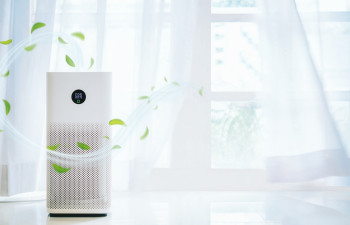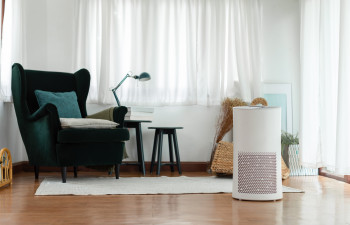Do air purifiers help with allergies?
What we think of as the common allergic reaction occurs when our immune systems overreact to a particular trigger, such as dust, pollen, or animal fur. Research indicates that the number of people suffering from allergies is rising.
The European Academy of Allergy and Clinical Immunology (EAACI) states that an allergy is the most common chronic condition in Europe, with up to 20% of people with allergies suffering from a severe form of allergy. They live with the possibility of an asthma attack, an allergic reaction, or going into anaphylactic shock on a daily basis.
Of the 10 most common causes of allergies, five can be found in the average household:
- Pollen – it’s not only house plants or cut flowers that leave pollen particles in the air. Every time a door or a window is opened, even the gentlest of breezes can push these powdery grains from plants, grasses, and trees into our homes. These grains are trapped in your furnishings where they can cause allergic reactions.
- Dust mites – the common dust mite can cause severe allergic reactions and bacterial infections. They live on protein-based waste and dead skin cells, which can be found in our bedding, furniture, and even cuddly toys.
- Mould contains tiny spores that are airborne and get into our nasal passages and throats, causing allergic reactions.
- Animal or pet dander is notorious for causing allergic reactions. Furniture and carpets in the home trap the pet skin cells that can trigger allergy attacks.
- Perfumes or household chemicals – if you are particularly sensitive to scents that are found in many types of air fresheners, perfumes, household sprays, and cleaning products, it is quite possible you will suffer an allergic reaction.
We breathe in these air pollutants daily, although we’re not always aware of them. Airborne particles hang in the air and circulate around the home unless there is excellent ventilation. But that can be difficult to achieve when the weather is cold, wet and windy.
So, what can you do to help clean the air in your home or office? One solution is air purifiers – let’s take a closer look at how air purifiers help with allergies.
Air purifiers and allergies
Air purifiers are designed to freshen the air in a home by drawing in the air and its airborne particles that cause allergies, cleaning the air by pushing it through a filtration system, and releasing it to recirculate.
The particles from the air, such as pollen, dust mites, mould, and pet dander go into a mechanical filter where they become trapped. The important element in many air purifiers is the true HEPA filter, which was developed by scientists working on the Manhattan Project as a way of removing tiny radioactive particles. Over the years, the true HEPA filter has become commercially viable in air purifiers.
True HEPA filters – HEPA stands for High Efficiency Particulate Air – are designed and rated to trap dust particles that are as small as 0.3 microns at an efficiency of 99.97%. Used daily, an air purifier can significantly reduce the level of dust mites and other airborne particles that cause allergy symptoms.
Air purifier filters are generally made from a fibreglass mesh with holes small enough to trap dust particles the purifier draws in, before pushing out the clean air. The filters must be replaced regularly as they will clog up with particles and become ineffective over time.
The HEPA filters are made of very fine fibreglass threads that are pleated in sheets and sealed in a frame. Larger particles are trapped almost as soon as they hit the filter. Smaller dust particles might pass through the larger holes but the ultra-small holes will stop tiny particles.
Some air purifiers incorporate filters that you can gently wash with a mild soapy solution and then reuse. Other models feature activated carbon filters that absorb further air pollutants that cause allergy symptoms, such as volatile organic compounds (VOCs) which are often found in household cleaning products.
The size of the air purifier and the area it is able to purify will largely determine where you put your air purifier for allergies. For example, if your allergies and asthma symptoms are at their worst in the living room, which is generally the largest room in the home, you will need an air purifier with a high efficiency to clean the air in that room. The fan speeds of air purifiers will have an impact on how much air it can clean and push back out to circulate through the room.
The best way to determine which type of air purifier is best for allergies is to calculate the CADR (clean air delivery rate). This measurement was developed by the Association of Home Appliance Manufacturers (AHAM), to report the amount of air a filtration system can remove and clean in an hour.
A higher CADR means the air purifier is quicker and more effective. Make sure the air purifier has certified performance against allergen particles provoking allergy and asthma.
Another factor to consider is where to place the air purifier in the room. It is generally recommended to place it near an open space, such as a door or window, because:
- The more air the air purifier can draw in, the faster it can clean the air and recirculate it. If windows and doors are open, there is more airflow.
- Areas with high levels of airborne particles mean the air purifier can catch the airborne particles before they have a chance to spread around the home and office, and settle on surfaces.
- This can help to prevent the spread of pet dander and pet hair around the house.
Always keep the vents on the air purifier clear of any blockages. Avoid putting them in corners or against walls, and make sure there is plenty of space around them so they can work at high efficiency.
Air purifiers for allergies don’t usually work as well in bathrooms or kitchens because these rooms are often more humid, which means the air purifier will be less efficient. In these areas, you may want to consider getting a dehumidifier to work alongside your air purifier or improve ventilation.
In many commercial buildings, air purifiers are incorporated into built-in air conditioning systems, but there is also a range of portable air purifiers available. Some of these are small enough to place on a table.
While air purifiers for allergies won’t remove 100% of the airborne particles from a home or home office, they will go a long way to removing most of the allergy-causing airborne particles.
How do you reduce allergens in the air?
As well as using air purifiers for allergies, there are a variety of other ways to reduce allergens in the air:
- Stop bringing in dust and other particles from outside. Some allergens, like pollen and pet dander, can enter your home on your shoes. Always have a mat at the door to catch these particles, or ask people to remove their shoes before they enter.
- Take exterior layers of clothing. As with your shoes, allergens will also stick to what you're wearing, so when you enter the home, take off outer layers such as coats, as soon as possible, and put them in a separate area, such as a closet with a door you can close.
- Wash regularly. As soon as you get home, get in the shower and wash away allergens with a mild, soap-free, fragrance-free cleanser. Airborne particles, such as pollen, stick to your hair and eyelashes.
- Vacuum floors regularly. Allergens, such as pet dander, dust mites, and pollen, settle on surfaces and into carpets. Vacuuming regularly with a machine that has a HEPA filtration system ensures that even the smallest of dust particles are lifted and trapped. If you have wall-to-wall carpets, consider steam or dry cleaning once a week as well to ensure allergen removal. If you suffer badly from allergies, you may want to consider getting allergen-resistant flooring, such as wood or floor tiles, throughout the house. These surfaces are much easier to keep clean and there are no fibres where allergens can embed themselves. If you do want to use rugs, choose ones that have no pile, or a short pile. Wool is a good choice as it is less attractive to mould.
- Deep clean your upholstery. As with carpets, allergens can also settle on furniture and its upholstery. If your sofa and chairs are leather or wood, a regular polish should remove any dust mites, pollen, and pet dander. However, fabric upholstery will need a more thorough cleaning. Many cushions and some sofas have removable covers which you can machine wash weekly. Otherwise, consider steam or dry cleaning at the same time you do the carpets.
- Get rid of bedroom dust. We sometimes forget that our bedrooms can be a haven for allergens, particularly dust mites. Wash the bedding at least once a week, on a hot wash, to kill off the dust mites. Any throws or cushions will also need regular cleaning, and dry clean the curtains, too.
- Beware the houseplant. If you love indoor plants, be careful as some produce pollen that can affect allergy sufferers. Some houseplants can be helpful, such as those that absorb VOCs, but generally, most houseplants attract dust, can grow mould, or disperse pollen at certain times of the year.
The above measures can all be used in conjunction with air purifiers for allergies to help reduce the effects of allergens significantly.





